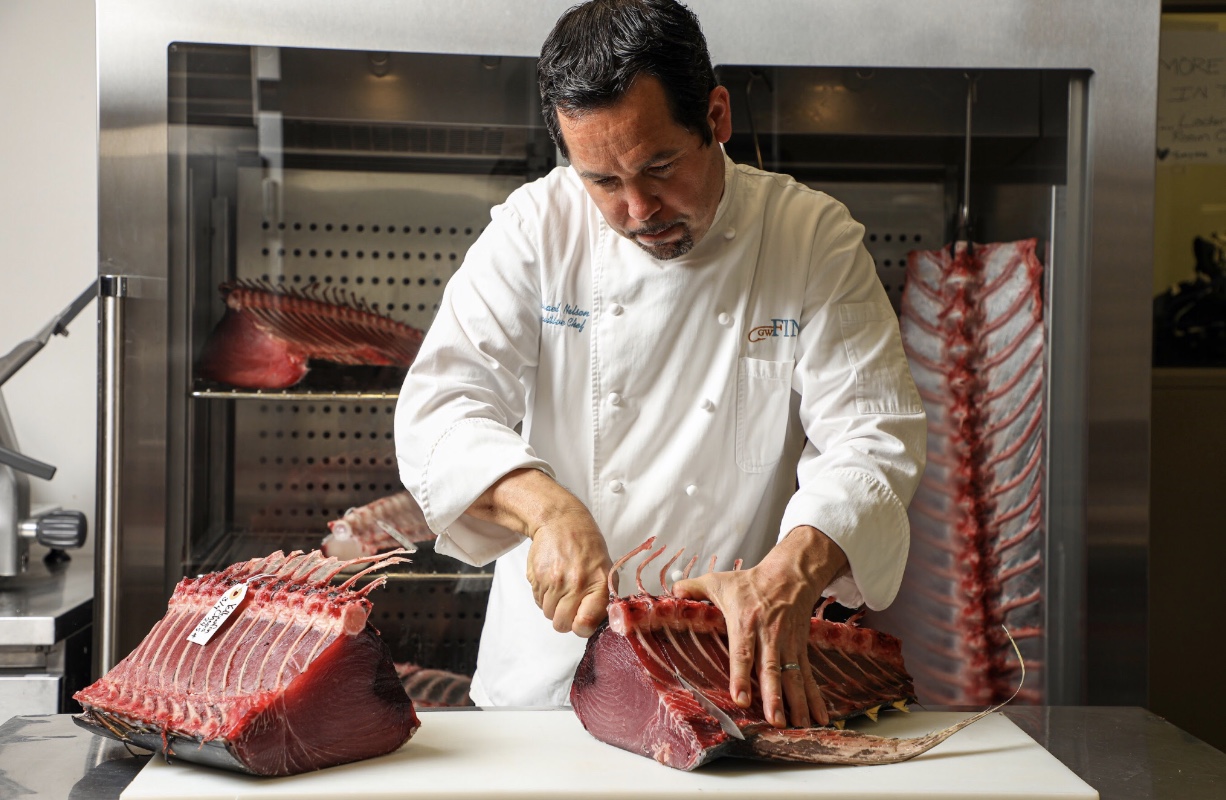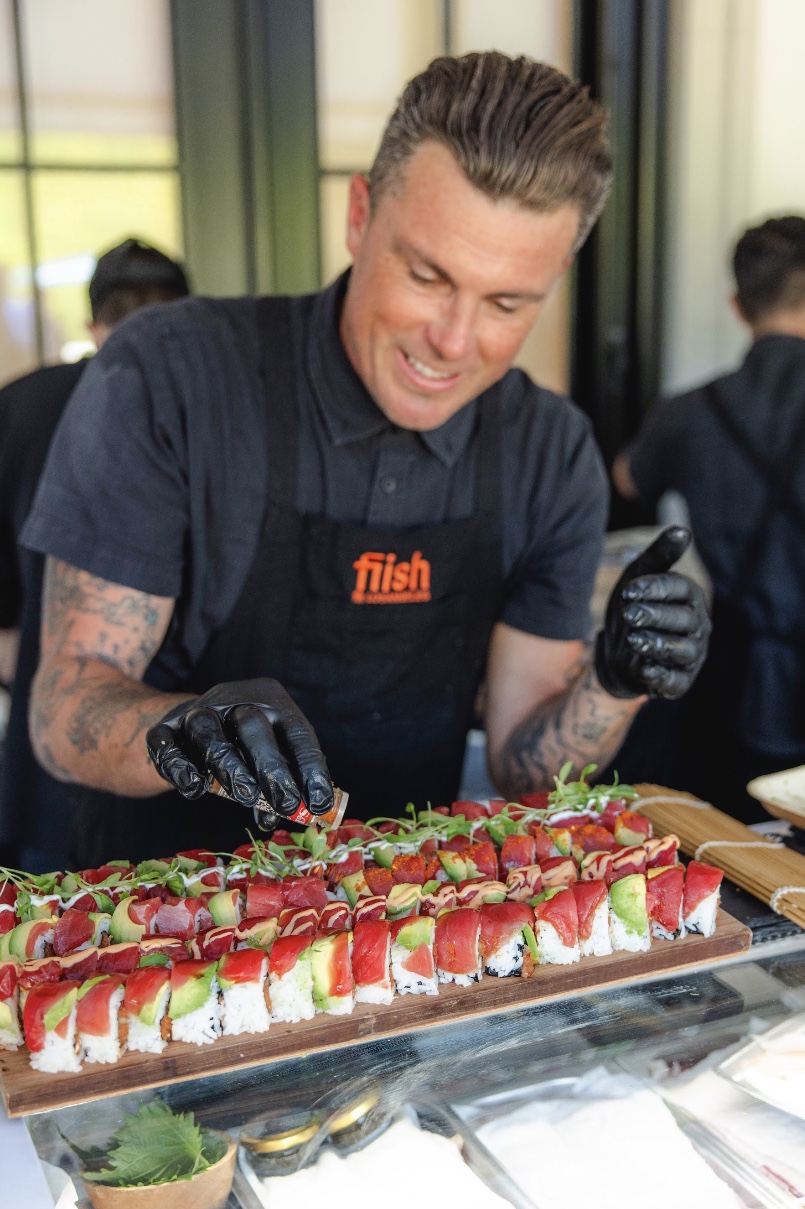Chefs get creative when it comes to reducing seafood waste
By Misty Milioto
Chefs across the country are starting to catch on to the phenomenon of dry-aging fish as a way to reduce waste and develop creative dishes. Here, we caught up with two chefs — Michael Nelson, executive chef at GW Fins in New Orleans, and Colin Whitbread, chef and co-founder at Fiish in Los Angeles, to get the angle on this innovative and sustainable method.
Michael Nelson, Executive Chef, GW Fins
 From his perch as executive chef at GW Fins, a seafood-forward restaurant in New Orleans’ French Quarter, James Beard Foundation Award-nominated Michael Nelson resolved to innovate seafood during the pandemic. He decided to try dry-aging fish — a tradition that sushi chefs in Japan have mastered over the years.
From his perch as executive chef at GW Fins, a seafood-forward restaurant in New Orleans’ French Quarter, James Beard Foundation Award-nominated Michael Nelson resolved to innovate seafood during the pandemic. He decided to try dry-aging fish — a tradition that sushi chefs in Japan have mastered over the years.
“From my 18 years of experience specializing in fish, I know that fresh fish tastes better a day or two out of the water,” Nelson says. “It needs time to rest and relax to let the flavor develop, so I was curious what the dry-aging process would do. I heard about some chefs doing this with incredible results in Australia, and one chef in LA, and I wanted to try it. I did a lot of research and was intrigued by the idea of being able to modify and enhance the flavor and texture of the fish to such a dramatic degree.”
Nelson started off dry-aging tilefish, which he says has a watery consistency and skin that one would never want to eat. After just five days in the dry-aging cabinet, the flavor of the fish was dramatically more pronounced, the fish became more dense, and the skin had a crispy, almost cracklin’-like texture.
After a lot of experimentation, he found the perfect formula for dry-aging a variety of fish. Since then, he has dry-aged everything from Ōra King salmon to swordfish, snapper, and more. However, he has found that bluefin tuna, yellowfin tuna, and swordfish are the perfect fishes to dry-age.
Today, Nelson is one of only a few chefs in the United States to use a temperature- and humidity-controlled environment to dry-age fish. At any given time, there could be up to 1,000 pounds of fish in the dry-aging cabinets at GW Fins. And guests at the restaurant are not only ordering the dry-aged fish again and again — any type of dry-aged fish is the first dish to sell out every evening — but they are also leaving with rave reviews.
In addition to creating really tasty dishes, dry-aging also reduces a lot of waste.
“We only get in whole fish at GW Fins, and when we get a several-hundred-pound swordfish or tuna, even though we’re busy, we can’t go through that product right away,” Nelson says. “Dry-aging allows us the opportunity to break the fish down and serve a large portion of the fish, then also put some in the dry-aging cabinets where it stays for about two weeks.”
As part of his mission to increase seafood sustainability, Nelson has come up with some innovative ways to butcher fish in order to use almost every part, from fin to tail. In fact, his butchering techniques yield 60% more meat (leaving virtually no meat on the scales) from every fish that comes through his doors, which is between 700 to 1,000 pounds per day. The James Beard Foundation even had Nelson conduct a boot camp for other chefs to show them how to adapt these butchering skills to increase fish utilization.
Through the process of dry-aging and using innovative butchering techniques to yield unique cuts of fish, Nelson has added some creative dishes to the GW Fins menu, like crispy fish bellies and the popular tempura fin wings (fish collars) served with a Korean glaze.
There’s also inspired seacuterie, which came about from Nelson’s butchering techniques. He has made everything from kielbasa and andouille sausage to pepperoni and more using parts of the swordfish other than the filet. These modified dishes taste just like pork but without the high fat content. Nelson even has used his Seacuterie to re-create the iconic New Orleans sandwich (the muffuletta) as well as a bacon cheeseburger slider — using only swordfish. Both of these dishes are served as appetizers when available. The menu changes nightly and is printed at 4 p.m. based on the fish that is available each day. 808 Bienville St., New Orleans, 504.581.3467, www.gwfins.com
Colin Whitbread, Executive Chef and Co-founder, Fiish
 Colin Whitbread is a sushi chef, surfer, and artist who is passionate about the ocean and sustainable seafood practices. He has operated an ethically sourced sustainable sushi business for more than 15 years, with a focus on line-caught seasonal local fish and sustainable farm-raised products. In 2021, Whitbread and his chef partner Cody Requejo co-founded Fiish — a sustainable sushi restaurant located in Culver City’s Platform LA — specializing in sustainably sourced, dry-aged fish and innovative sushi. The original pop-up location at Platform LA, dubbed Little Fiish, was a fast-casual concept where guests could order bento boxes made-to-order, salads, and natural sodas. At the same time, Whitbread and his team worked on the build-out of the main Fiish restaurant.
Colin Whitbread is a sushi chef, surfer, and artist who is passionate about the ocean and sustainable seafood practices. He has operated an ethically sourced sustainable sushi business for more than 15 years, with a focus on line-caught seasonal local fish and sustainable farm-raised products. In 2021, Whitbread and his chef partner Cody Requejo co-founded Fiish — a sustainable sushi restaurant located in Culver City’s Platform LA — specializing in sustainably sourced, dry-aged fish and innovative sushi. The original pop-up location at Platform LA, dubbed Little Fiish, was a fast-casual concept where guests could order bento boxes made-to-order, salads, and natural sodas. At the same time, Whitbread and his team worked on the build-out of the main Fiish restaurant.
“We were excited to start sharing our vision and teaching the community about what we love to do,” Whitbread says. “We quickly closed up the physical shop once our build in the main restaurant was completed and resumed this concept for take-out only through Fiish as a convenience for those on-the-go as an alternative to a seated meal at the sushi bar.”
For Whitbread, sustainability is front and center at Fiish.
“By choosing to go in the sustainable direction, we are making an effort to prepare our food system for the future,” he says. “Trying to be low- or zero-waste and trying to be conscious of the products we’re using and how they are created is going to help. It is, for me, the most important aspect of being a chef: trying to create a new food system that can evolve with time and be able to adapt to the growing needs and pressures that are being put upon the culinary world.”
Whitbread and Requejo source the majority of their fish directly from local docks and sustainable aquaculture farms that have Aquaculture Stewardship Council certifications and a Best Aquaculture Practices rating. Both of these systems focus on traceability, environmental impact, feed ratios, pen densities, chemical treatments (antibiotics), and social responsibility.
For example, the chefs source Fiish’s striped bass from Pacifico Aquaculture, a farm that offers open-ocean raised, sashimi-grade striped bass off the coast of Todos Santos Island, Mexico — just three hours away from the restaurant, making it Fiish’s most local catch. Meanwhile, the Ōra King salmon comes from New Zealand King Salmon, a company committed to sustainability, environmental responsibility, and the highest standards of fish welfare. Other sustainably sourced fish include Omega Blue Kanpachi from La Paz, Mexico; stone bass from the Ionian and Aegean seas in Greece; Albacore tuna from Fiji; Bigeye tuna from Honolulu; and Vermilion rockfish from San Francisco.
Once Fiish receives the fresh catches, the team processes the fish and dry-ages it for five to 12 days, depending on the species. In doing so, Fiish is able to serve premium, never-frozen seafood, while also allowing its chefs elasticity in the supply chain, resulting in reliable stock and minimal loss.
“I believe [dry-aging] will become more popular as the information gets out there and people have more experience in doing it,” Whitbread says. “It will most likely be one of the most popular methods used in fish production and fish longevity in the future for chefs.” 8820 Washington Blvd., Ste. 101, Culver City, 323.272.2262, www.fiish.co






